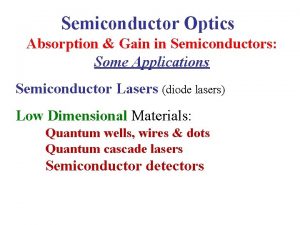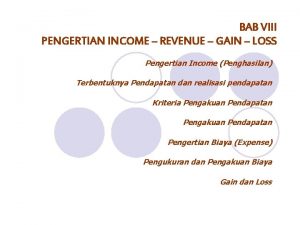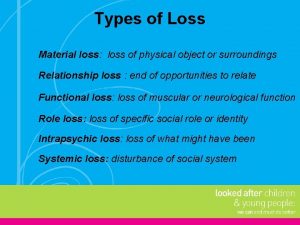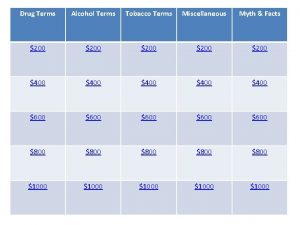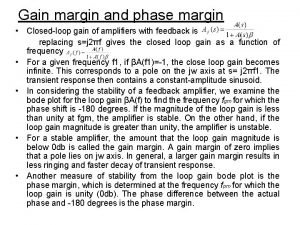Gain and loss The terms gain and loss





































- Slides: 37

Gain and loss • The terms gain and loss enter the standard dictionary of Photonics. • They refer to OPTICAL GAIN • Both are simply ( g , and OPTICAL LOSSES a. T, am, ai… ) different ways for describing known phenomena. • In two cases they are explicitly used in literature and other textbooks: Link between PTOT and POUT Loss terms for I>Ith Empirical definition of a current-gain relationship gain Itr= current I at transparency g 0= empirical fitting parameter

In order to properly introduce gain and losses, let us go back to the rate equation. It describes how the spectral photon density rates of change with respect to time. Rsp Rst Rabs Resc

In order to properly introduce gain and losses, let us go back to the rate equation. It describes how the spectral photon density rates of change with respect to time. Rsp Rst Rabs Resc If we divide everything by the light speed inside the medium, c, we move from time to space rates of increase/decrease For the steady case it follows the uniformity of the photon density

In order to properly introduce gain and losses, let us go back to the rate equation. It describes how the spectral photon density rates of change with respect to time. Rsp Rst Rabs Resc If we divide everything by the light speed inside the medium, c, we move from time to space rates of increase/decrease For the steady case it follows the uniformity of the photon density Let us handle the equation a little… …and prepare to divide everything by fn.

Let us now divide by the photon density Percent spatial rate of change of fn Contribution of spontaneous emission absolute gain and introduce the definition of gain and losses net gain g optical absorption optical losses

Percent spatial rate of change of fn net gain g Contribution of spontaneous emission absolute gain This makes little sense in general, but optical absorption optical losses • Voltage V is clamped at Vth • Electron and holes densities pnnn are blocked • Photon density f n is high at laser regime: Percent spatial rate of change of fn absolute gain optical absorption gain at threshold=maximum gain optical losses

Gain and Loss coefficients Let us make voltage explicit in and then define Physical dimensions for both So that the coefficient R that appears in the solution of the rate equation is written as: It is dimensionless We now rewrite the steady state rate equation in term of gain and loss coefficients

«Net gain = Pure gain – Absorption = g = G- αabs » «Absorbtion = αabs » «Escape loss = α » treshold «Pure gain = G» transparency «Spontaneous gain» spont gain pure gain absorption 0, 95 1, 05 V Net gain g is negative up to transparency. 1, 15 It saturates at threshold

It is common practice to neglect the spontaneous emission even below the laser regime. It is a mistake. But it leads to standard image of gain and loss ruling over an exponential rate of change of • Exponential decay for • Uniform density for • Exponential increase for Which values can g assume?

Gain g is a function of V and n. • Its values range from - gm to gm. • gm is a function of n, but not of V. It is null for hn < Eg. q. V By the way, this tells that the empirical function in slide 1, that is unlimited, is wrong. hn

Voltage V is then a function of g and n. …but we know that voltage V may saturate provided

• If the laser regime will NEVER be reached. • gain g will range from - gm to gm. • Our diode will remain a Light Emitting Diode (LED)

• If the laser threshold does exist. • gain g will range from - gm to a. T. • Our diode will become a laser at the pair for which the latter is minimum


GAIN SATURATION Experiments I Vext V I V saturation leads to g saturation Experimental V=Vext-RSI Experimental g/gm

SATURATIONs • Gain g saturates • Voltage V saturates • Current I does not saturate BUT has a threshold value Ith that corresponds to where Ca we explore the link between g and currents?

From g(V) to g(I) First we get the exponentials with V Then we substitute in the current equations

From g(V) to g(I) A formula for g(I) Corresponds to Inr(hn) Corresponds to Iph(hn) that are the values of Inr and Iph at transparency

Gain saturation and threshold current Non radiative current as a function of g = the value of Inr at transparency Threshold current= maximum of Inr

Losses

R 2 n-doped n n 0 R 1 n 0 p-doped L Total losses αT occur both along the path (we call this internal part αi ) and at the edges (we call this edge part αm ) Progressive loss along the path. It makes sense Local losses at boundaries ( «mirrors» ) ? ? ? How to include it ? ? ?

Let us consider a purely loosing path (no gain) with distributed losses and partial reflections Number of round trips Average travelled path: Probability to have a surviving photon Travelled path

For a well designed devices, with low losses If the light propagation speed inside the material is the average time spent by a photon before escaping is This is exactly the average permanence time inside the active region that enters the fourth term of the rate equation and then: Internal escapes Total escapes Mirror escapes

Losses and the LI curve 1 E-04 Incr easi ng a 1 E-04 POUT 8 E-05 T 6 E-05 4 E-05 2 E-05 0 E+00 0, 000 Ith h 0, 005 0, 010 I(A) 0, 015

Wave effects on round trips (Hakki-Paoli method for gain measurement) R 2 n-doped n n 0 p-doped L R 1 n 0

Photon density Field propagation At any time t and any place x, all fields due to photons after one, two, and more round trips add up

After one round trip of length 2 L After n round trips Adding up all fields we get the total field

Going back to photon density The square modulus of the function F 0 is modulated by an oscillating function Fabry-Perot cavity and resonances

Maxima and minima

Gain measurement from maxima and minima This is the Hakki-Paoli method: B. W. Hakki, T. L. Paoli, “Gain spectra in Ga. As double−heterostructure injection lasers”, J. Appl. Phys. , 46(3), pp. 1299 -1306, 1975.

Fabry Perot resonances and Etalon characteristics First, a simple substitution


FABRY-PEROT RESONANCES ETALON TRANSMISSION FUNCTION

This points out a frequency-dependent modulation of αm, and then of αT , and then of resonances ��


Mode separation L = 1 mm l = 1 mm n =3 m typically = some thousands Mode separation < 1 nm 150 modes within 1 k. T

e s ci r xe E Depends on l • • • Calculate the real wavelength L+1 mm: what is the l shift? Calculate Dl Calculate Dn Calculate Dhn/k. T L = 0. 258 mm l = 1. 310 mm n = 3. 5 Does not depend on n h = 6. 626 x 10 -27 erg. s c = 2. 998 x 1010 cm/s e. V = 1. 902 x 10 -12 erg k. T = 0. 0259 e. V
 Semiconductor
Semiconductor Gain / loss
Gain / loss Like terms and unlike terms in polynomials
Like terms and unlike terms in polynomials Combining like terms definition
Combining like terms definition Scrap account
Scrap account Hát kết hợp bộ gõ cơ thể
Hát kết hợp bộ gõ cơ thể Ng-html
Ng-html Bổ thể
Bổ thể Tỉ lệ cơ thể trẻ em
Tỉ lệ cơ thể trẻ em Gấu đi như thế nào
Gấu đi như thế nào Tư thế worms-breton
Tư thế worms-breton Hát lên người ơi alleluia
Hát lên người ơi alleluia Các môn thể thao bắt đầu bằng tiếng đua
Các môn thể thao bắt đầu bằng tiếng đua Thế nào là hệ số cao nhất
Thế nào là hệ số cao nhất Các châu lục và đại dương trên thế giới
Các châu lục và đại dương trên thế giới Công thức tính độ biến thiên đông lượng
Công thức tính độ biến thiên đông lượng Trời xanh đây là của chúng ta thể thơ
Trời xanh đây là của chúng ta thể thơ Mật thư tọa độ 5x5
Mật thư tọa độ 5x5 101012 bằng
101012 bằng Phản ứng thế ankan
Phản ứng thế ankan Các châu lục và đại dương trên thế giới
Các châu lục và đại dương trên thế giới Thể thơ truyền thống
Thể thơ truyền thống Quá trình desamine hóa có thể tạo ra
Quá trình desamine hóa có thể tạo ra Một số thể thơ truyền thống
Một số thể thơ truyền thống Cái miệng nó xinh thế chỉ nói điều hay thôi
Cái miệng nó xinh thế chỉ nói điều hay thôi Vẽ hình chiếu vuông góc của vật thể sau
Vẽ hình chiếu vuông góc của vật thể sau Thế nào là sự mỏi cơ
Thế nào là sự mỏi cơ đặc điểm cơ thể của người tối cổ
đặc điểm cơ thể của người tối cổ Giọng cùng tên là
Giọng cùng tên là Vẽ hình chiếu đứng bằng cạnh của vật thể
Vẽ hình chiếu đứng bằng cạnh của vật thể Phối cảnh
Phối cảnh Thẻ vin
Thẻ vin đại từ thay thế
đại từ thay thế điện thế nghỉ
điện thế nghỉ Tư thế ngồi viết
Tư thế ngồi viết Diễn thế sinh thái là
Diễn thế sinh thái là Dot
Dot Các số nguyên tố là gì
Các số nguyên tố là gì
